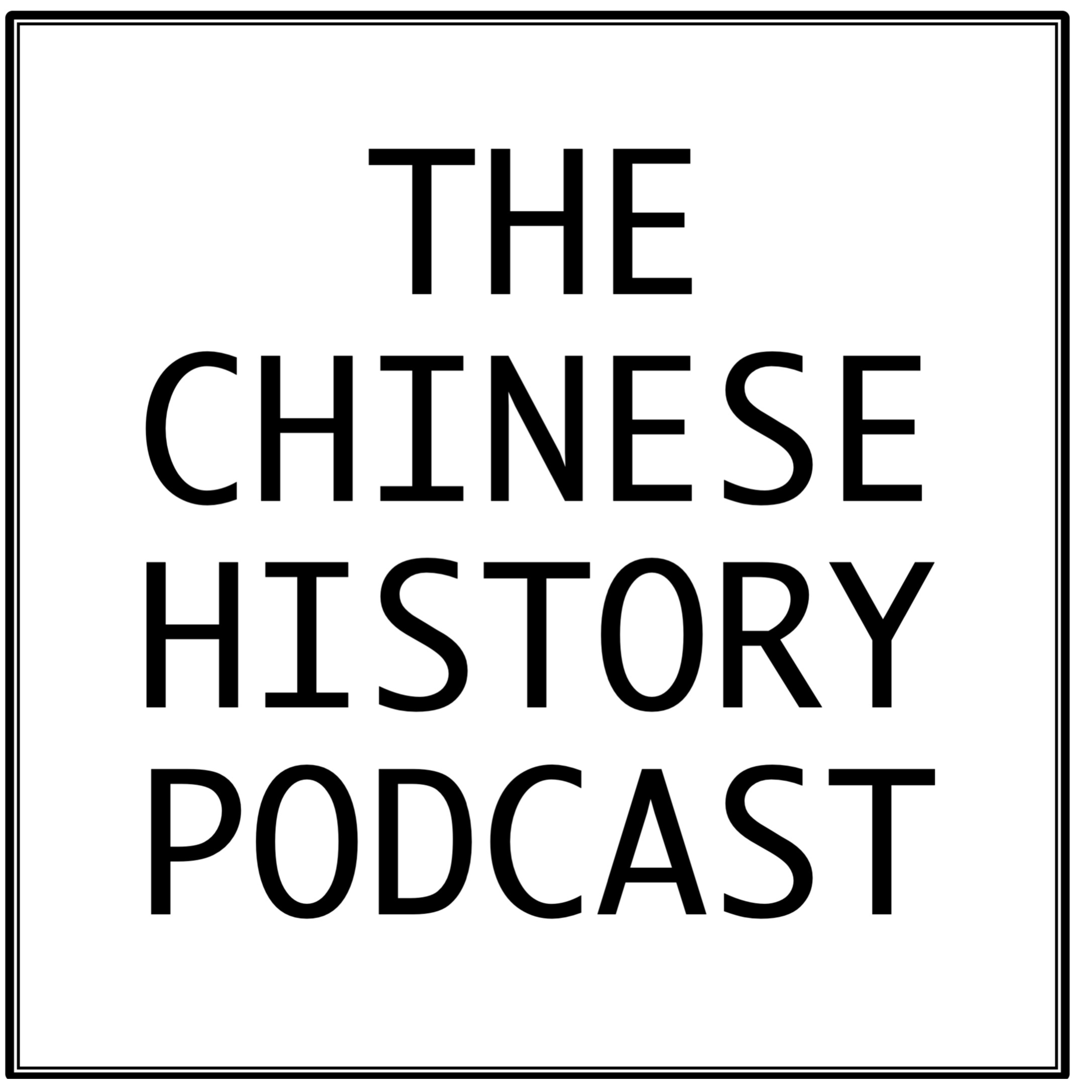Episodes
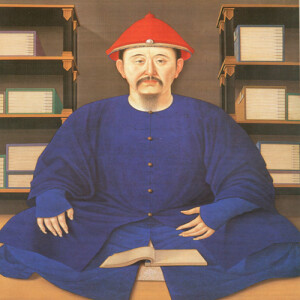
Friday Mar 01, 2024
Friday Mar 01, 2024
The Ming-Qing transition was an extremely chaotic time in Chinese history. Millions died of warfare, pestilence, or starvation, and millions more were displaced. Yet despite all these issues, this was also a period of cultural production, which has often been overlooked as people focus on the wars, famine, and climate change that pervaded this period. In this episode, I speak with Professor Lynn Struve about the literary pursuits of men and women and the overall intellectual landscape in the Late Ming and the Early Qing
Contributors
Lynn Struve

Lynn Struve is an emeritus professor of history and an emeritus professor of East Asian languages and cultures at Indiana University Bloomington. Her research interests include traditional Chinese history, 17th century political and intellectual history, East-West comparative thought, and Chinese reference and source materials. Over the course of her career, she has published widely, particularly on the period of the Ming-Qing transition, and has received numerous awards. Her representative works include Voices from the Ming-Qing Cataclysm: China in Tigers' Jaws, The Southern Ming, 1644-1662, The Ming-Qing Conflict: A Historiography and Source Guide, and, more recently, The Dreaming Mind and the End of the Ming World, which was recently awarded best overall book in Ming studies published between 2019 and 2022 by the Society for Ming Studies.
Yiming Ha

Yiming Ha is a Ph.D. candidate in the Department of History at the University of California, Los Angeles. His current research is on military mobilization and state-building in China between the thirteenth and seventeenth centuries, focusing on how military institutions changed over time, how the state responded to these changes, the disconnect between the center and localities, and the broader implications that the military had on the state. His project highlights in particular the role of the Mongol Yuan in introducing an alternative form of military mobilization that radically transformed the Chinese state. He is also interested in military history, nomadic history, comparative Eurasian state-building, and the history of maritime interactions in early modern East Asia. He received his BA from UCLA and his MPhil from the Hong Kong University of Science and Technology.
Credits
Episode no. 18
Release date: March 1, 2024
Recording location: Bloomington, IN/Los Angeles, CA
References compiled by Yiming Ha
Images
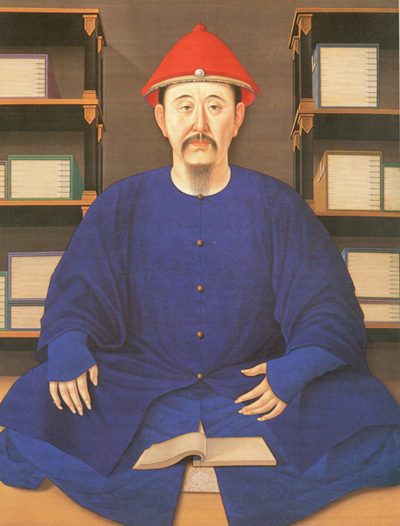
A portrait of the Kangxi emperor as a scholar, painted in 1699 when he was forty-five years of age. (Image Source)
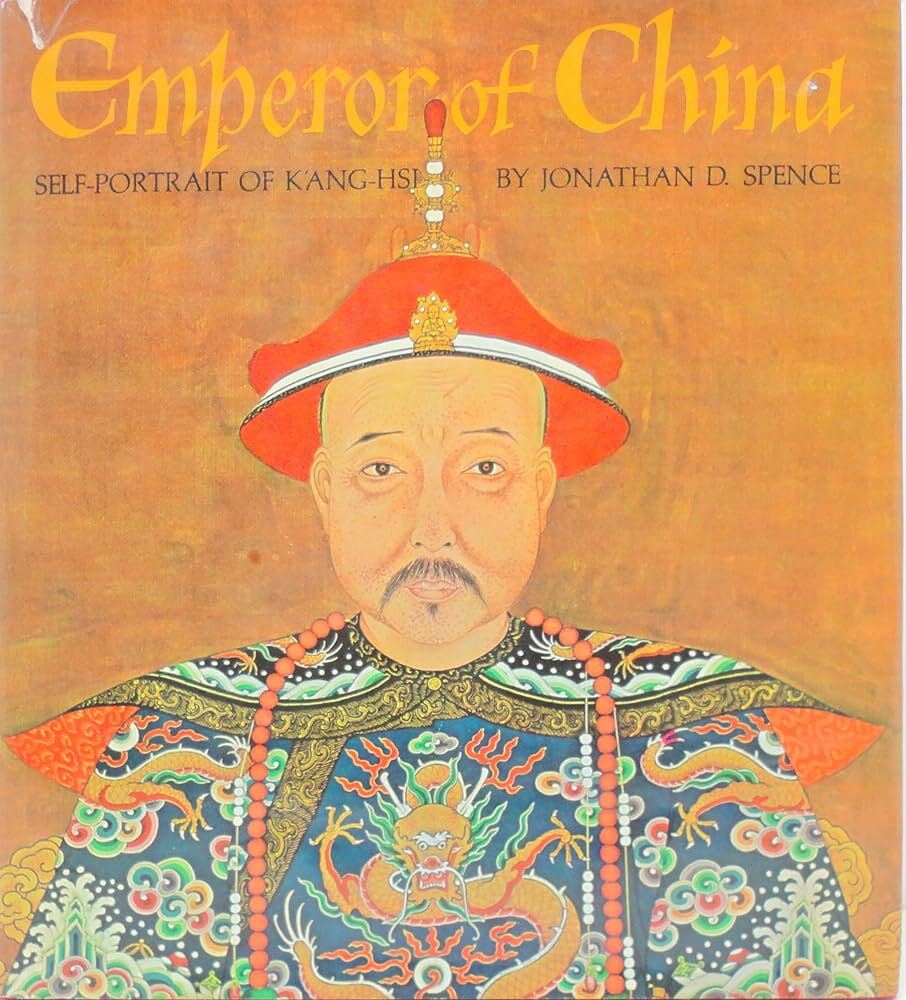
An alternative portrait of the Kangxi emperor that Jonathan Spence used for his book on the Kangxi emperor. This portrait shows the pockmarks on his face, a result of his childhood survival of smallpox which devastated the Manchu population. (Image Source)

A portrait of Huang Zongxi (1610-1695), one of the great scholars of the Late Ming and Early Qing. Originally a prominent figure in the Ming loyalist movement, Huang retired from Ming loyalism but also refused to serve the Qing. Nonetheless, Huang made many contributions to scholarship by indirectly accommodating the Qing. (Image Source)
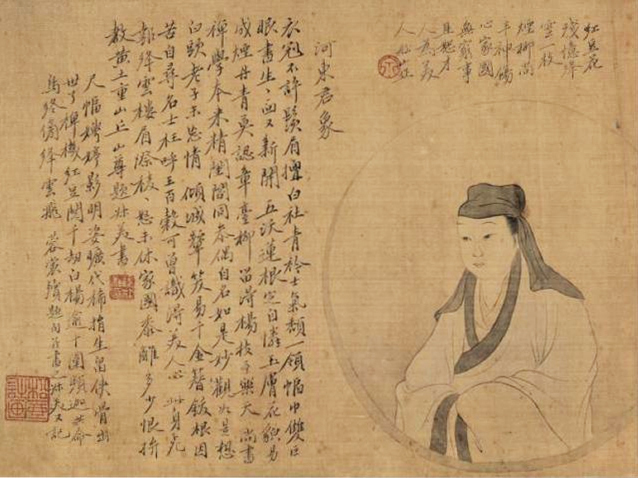
A late 18th/early 19th century portrait of Liu Rushi (1618-1664), one of the most famous courtesans of the 17th century and a prominent female scholar. (Image Source)
Select References
Brook, Timothy. The Price of Collapse: The Little Ice Age and the Fall of Ming China. Princeton: Princeton University Press, 2023.
Ko, Dorothy. Teachers of the Inner Chambers: Women and Culture in Seventeenth-century China. Stanford University Press, 1994.
Struve, Lynn. The Dreaming Mind and the End of the Ming World. Honolulu: University of Hawaii Press, 2019.
Widmer, Ellen. The Beauty and the Book: Women and Fiction in Nineteenth-century China. Cambridge, MA: Harvard University Asia Center, 2006.
Widmer, Ellen. The Inner Quarters and Beyond Women Writers from Ming Through Qing. Leiden: Brill, 2010.
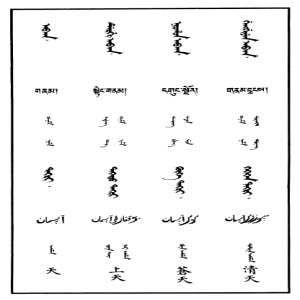
Friday Mar 03, 2023
Professor Pamela Crossley on History and Identity in Qing Imperial Ideology
Friday Mar 03, 2023
Friday Mar 03, 2023
The Qing Empire (1636-1912) ruled over one of the largest land empires in the world. Its territories encompassed not only what is considered today to be China proper and Manchuria, but also Tibet, Xinjiang, and Mongolia. Its subjects were composed of people belonging to different identities, of which Manchu, Han, Mongol, Tibetan, and later Uighur became the most important groups. As an empire that was composed of a small conquering elite, how did the Qing manage these different identities as its empire expanded and stabilized? What changes occurred over time? What legacy did the Qing leave on the Republic of China and the People's Republic of China in terms of how they dealt with ethnic minorities? To help answer these question, we invite Professor Pamela Crossley to talk to us about how history and identity were constructed and weaved into Qing imperial ideology.
Contributors
Pamela Crossley

Professor Pamela Crossley is the Charles and Elfriede Collis Professor of History at Dartmouth University. She specializes in the history of the Qing Empire and modern China, although her research interests also span Inner Asian history, global history, history of horsemanship in Eurasia, and imperial sources of modern identities. She is the author of eight books and numerous book chapters and peer-reviewed articles, and her book A Translucent Mirror is the winner of the Joseph Levenson Prize of the Association of Asian Studies. Additionally, she has also written commentaries for major newspapers and magazines.
Yiming Ha

Yiming Ha is a Ph.D. candidate in the Department of History at the University of California, Los Angeles. His current research is on military mobilization and state-building in China between the thirteenth and seventeenth centuries, focusing on how military institutions changed over time, how the state responded to these changes, the disconnect between the center and localities, and the broader implications that the military had on the state. His project highlights in particular the role of the Mongol Yuan in introducing an alternative form of military mobilization that radically transformed the Chinese state. He is also interested in military history, nomadic history, comparative Eurasian state-building, and the history of maritime interactions in early modern East Asia. He received his BA from UCLA and his MPhil from the Hong Kong University of Science and Technology.
Credits
Episode no. 17
Release date: March 3, 2023
Recording location: Hanover, NH/Los Angeles, CA
Transcript (by Yiming Ha and Greg Sattler)
Bibliography courtesy of Prof. Crossley
Images
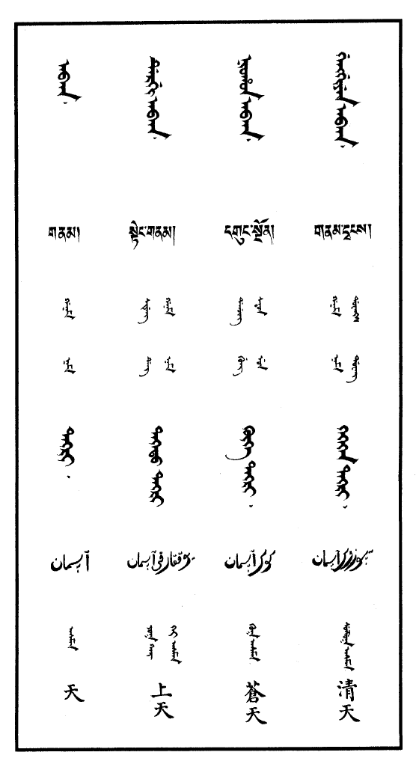
Cover Image: A page of the Pentaglot Dictionary (Yuzhi wuti qing wenjian 御製五體清文鑑), a dictionary of the major languages of the Qing compiled towards the later reign of Emperor Qianlong in the 18th century. The five languages are Manchu, Chinese, Mongolian, Tibetan, and Chagatai (now known as Uighur). (Image Source)
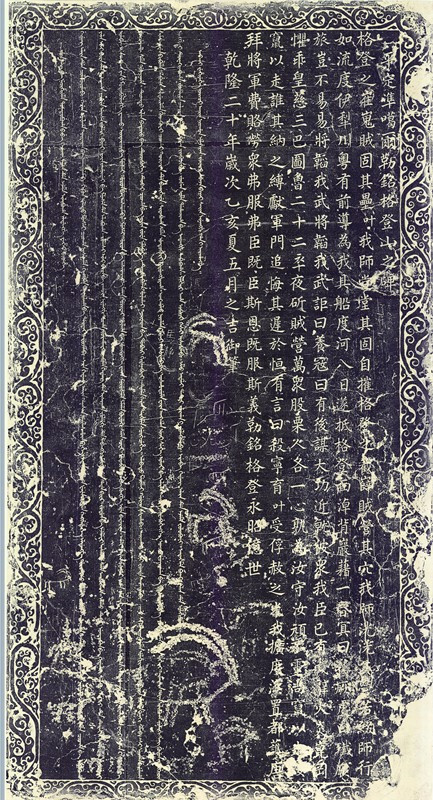
The Stele Commemorating the Victory over the Dzungars, erected by the Qianlong emperor either in the 1750s or 1760s to commemorate the Qing victory over the Dzungars in the Xinjiang region. The stele featured four languages. On the front side are inscriptions written in Classical Chinese (by the Qianlong emperor himself) and Manchu, while the reverse side features inscriptions in Mongolian and Tibetan. (Image Source)
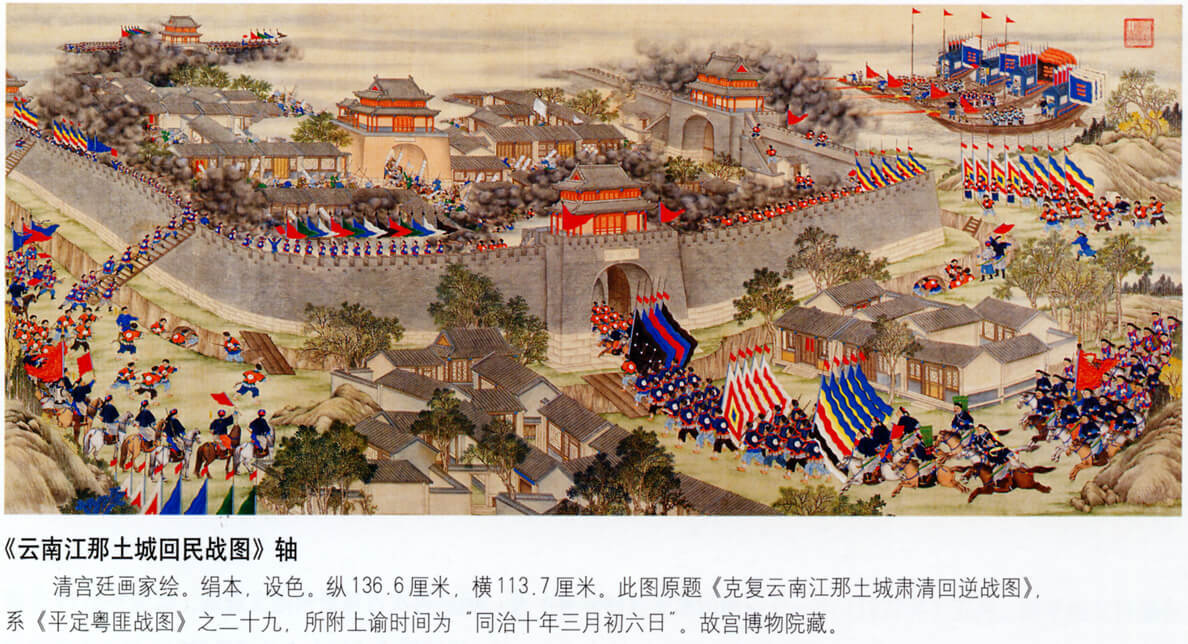
The Capture of Tucheng, a painting commemorating a Qing victory during the Panthay Rebellion in Yunnan (1856-1873). Note the five colored banner that were flown by the Qing troops. The alternate version of this flag (with the colors rearranged) later became one of the early flags of the Republic of China, with each color representing an ethnic group. Red for the Han, yellow for the Manchus, blue for the Mongols, white for the Hui (Muslims), and black for the Tibetans. (Image Source)
References
Bovington, Goardner, "The History of the History of Xinjiang" in Twentieth-Century China, 26:.2 (April, 2001): 95-139.
Bulag, Uradyn The Mongols at China's Edge: History and the Politics of National Unity (2002, Rowman & Littlefield)
Crossley, "The Cycle of Inevitability in Imperial and Republican Identities in China" in Aviel Roshwald, ed, The Cambridge History of Nationhood and Nationalism: Volume One: Patterns and Trajectories over the Longue Durée (2022, Cambridge), 301-328.
Crossley, Helen F. Siu, Donald S., Sutton, ed., Empire at the Margins: Culture, Ehtnicity and Frontier in the Early Modern China (California, 2006)
Crossley, A Translucent Mirror: History and Identity in Qing Imeprial Ideology (1999, California).
Elliott, Mark, The Manchu Way: The Eight Banners and Ethnic Identity in Late Imperial China (2002, Californai)
Perdue, Peter. C, ."Empire and Nation in Comparative Perspective: Frontier Administration in Eighteenth-Century China" in Journal of Early Modern History, 5:4 (2001, 282-304.
Jonathan D. Spence, Treason by the Book (2002, Viking).
Wu, Hung, "Emperor's Masquerade: 'Costume portraits' of Yongzheng and Qianlong" in Smithsonian Libraries, 1995, p. 25-41.
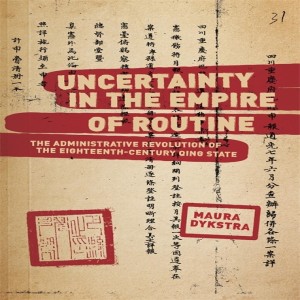
Tuesday Sep 20, 2022
Tuesday Sep 20, 2022
Professor Maura Dykstra of Caltech joins us today to talk about her new book titled Uncertainty in the Empire of Routine: The Administrative Revolution of the Eighteenth-Century Qing State. According to the publisher, the book "investigates the administrative revolution of China’s eighteenth-century Qing state. It begins in the mid-seventeenth century with what seemed, at the time, to be straightforward policies to clean up the bureaucracy: a regulation about deadlines here, a requirement about reporting standards there. Over the course of a hundred years, the central court continued to demand more information from the provinces about local administrative activities. By the middle of the eighteenth century, unprecedented amounts of data about local offices throughout the empire existed.
The result of this information coup was a growing discourse of crisis and decline. Gathering data to ensure that officials were doing their jobs properly, it turned out, repeatedly exposed new issues requiring new forms of scrutiny. Slowly but surely, the thicket of imperial routines and standards binding together local offices, provincial superiors, and central ministries shifted the very epistemological foundations of the state. A vicious cycle arose whereby reporting protocols implemented to solve problems uncovered more problems, necessitating the collection of more information. At the very moment that the Qing knew more about itself than ever before, the central court became certain that it had entered an age of decline."
Contributors
Maura Dykstra

Professor Maura Dykstra is an Assistant Professor of History at Caltech. As a historian of Late Imperial China, her research interests are on bureaucratic, economic, and legal institutions of empire and their implications for political and social interactions in quotidian contexts. Professor Dykstra received her PhD from UCLA and was a postdoctoral fellow at Harvard's Fairbank Center for Chinese Studies. In addition, she has held numerous residential fellowships and visiting positions in Europe and Asia. Starting in Fall of 2023, Professor Dykstra will begin a new position as Assistant Professor of Chinese History at Yale University.
Yiming Ha

Yiming Ha is a Ph.D. candidate in the Department of History at the University of California, Los Angeles. His current research is on military mobilization and state-building in China between the thirteenth and seventeenth centuries, focusing on how military institutions changed over time, how the state responded to these changes, the disconnect between the center and localities, and the broader implications that the military had on the state. His project highlights in particular the role of the Mongol Yuan in introducing an alternative form of military mobilization that radically transformed the Chinese state. He is also interested in military history, nomadic history, comparative Eurasian state-building, and the history of maritime interactions in early modern East Asia. He received his BA from UCLA and his MPhil from the Hong Kong University of Science and Technology.
Credits
Episode No. 15
Release date: September 20, 2022
Recording location: Los Angeles, CA
Bibliography courtesy of Professor Dykstra
Images
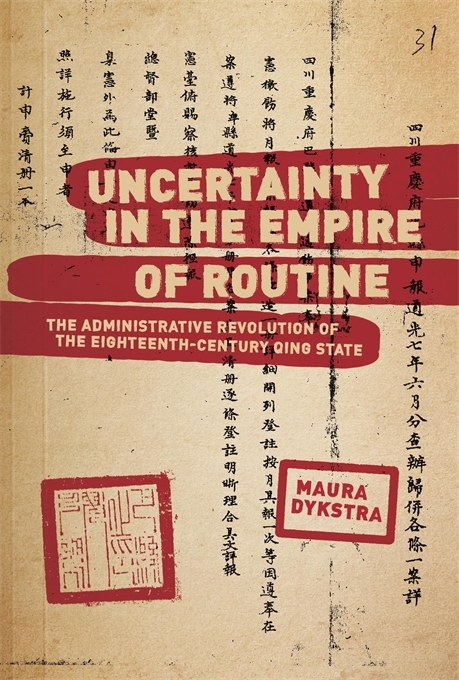
Cover Image: Cover of Professor Dykstra's book, which can be purchased directly from the publisher or from Amazon.

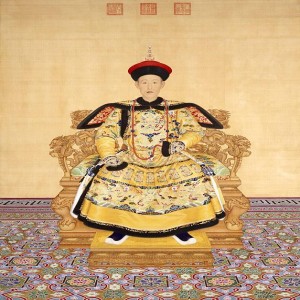
Saturday Jun 25, 2022
Professor Joanna Waley-Cohen on New Qing History
Saturday Jun 25, 2022
Saturday Jun 25, 2022
Since the 1990s, the New Qing History school has loomed large in the study of the Qing dynasty. It has greatly informed not only the study of the Qing but study of other dynasties as well. Yet what exactly is New Qing History? What is "new" about it? How did it come into being? How was it received in China and the West? To answer these questions, we talked to Professor Joanna Waley-Cohen of NYU, one of the leading scholars of the Qing dynasty.
Contributors
Joanna Waley-Cohen
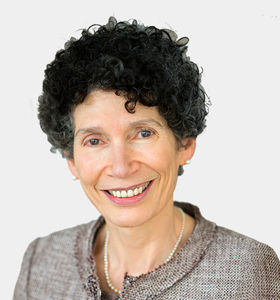
Professor Joanna Waley-Cohen is the Provost for NYU Shanghai and Julius Silver Professor of History at New York University. Her research interests include early modern Chinese history, especially the Qing dynasty; China and the West; and Chinese imperial culture, particularly in the Qianlong era; warfare in China and Inner Asia; and Chinese culinary history, and she has authored several books and articles on these topics. In addition, Professor Waley-Cohen has received many honors, including archival and postdoctoral fellowships from the American Council of Learned Societies, Goddard and Presidential Fellowships from NYU, and an Olin Fellowship in Military and Strategic History from Yale.
Yiming Ha

Yiming Ha is a Ph.D. candidate in the Department of History at the University of California, Los Angeles. His current research is on military mobilization and state-building in China between the thirteenth and seventeenth centuries, focusing on how military institutions changed over time, how the state responded to these changes, the disconnect between the center and localities, and the broader implications that the military had on the state. His project highlights in particular the role of the Mongol Yuan in introducing an alternative form of military mobilization that radically transformed the Chinese state. He is also interested in military history, nomadic history, comparative Eurasian state-building, and the history of maritime interactions in early modern East Asia. He received his BA from UCLA and his MPhil from the Hong Kong University of Science and Technology.
Credits
Episode no. 12
Release date: June 25, 2022
Recording location: Los Angeles, CA/New York, NY
Bibliography courtesy of Professor Waley-Cohen
Images
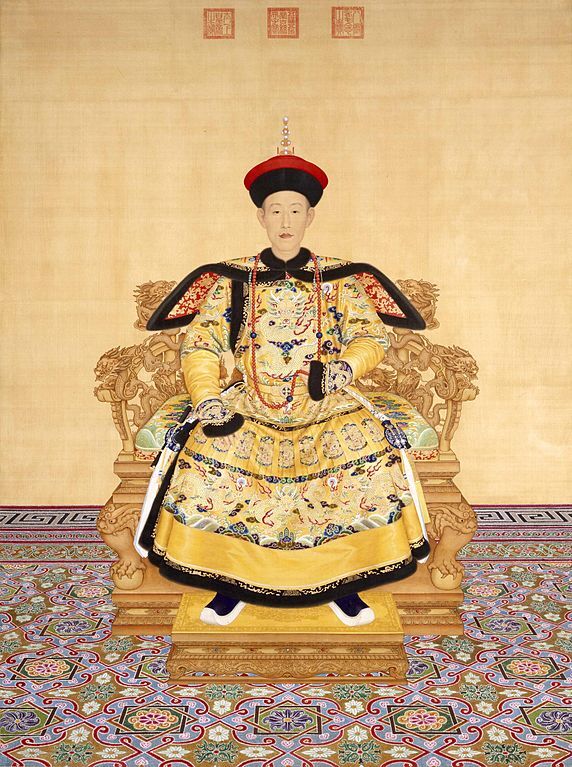
Cover Image: The Qianlong Emperor, who reigned from 1735 to 1796. After he abdicated, he continued to retain power as retired emperor until his death in 1799. He is the longest-reigning monarch in Chinese history and one of the longest in the world (Image Source).
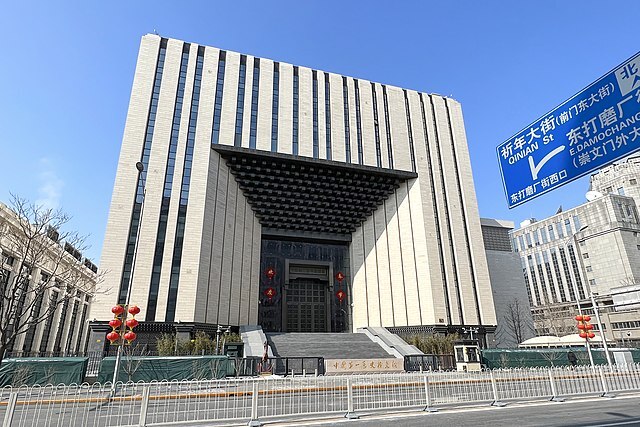
The headquarters of the First Historical Archives in Beijing, which houses documents from the Qing. The opening of this archive and access to the Manchu-language documents held within helped give birth to New Qing History. (Image Source)
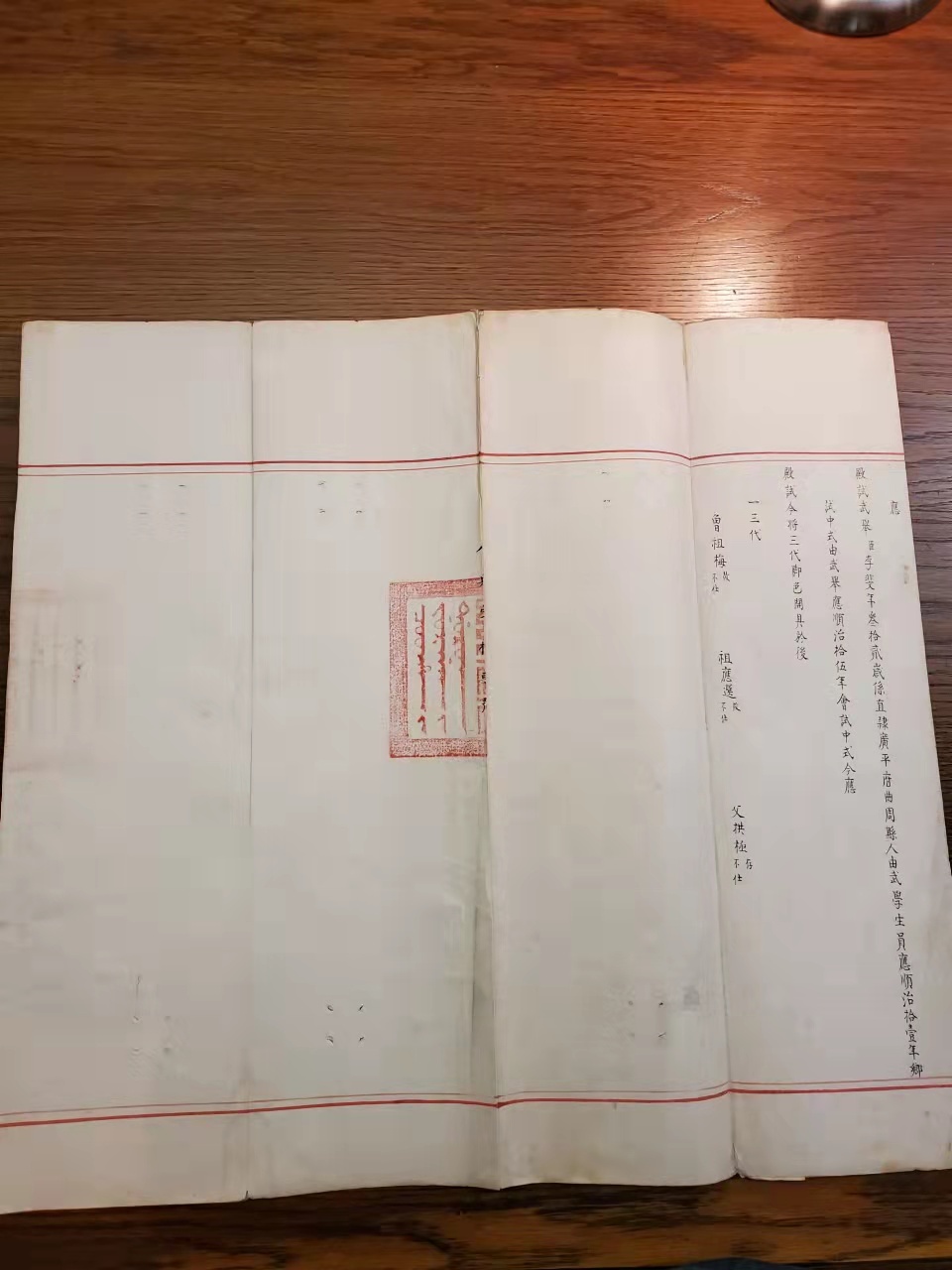
A copy of a Qing-era civil service examination answer sheet. Note the Manchu script on the seal. Currently held in UCLA Library Special Collections (Photo by Yiming).
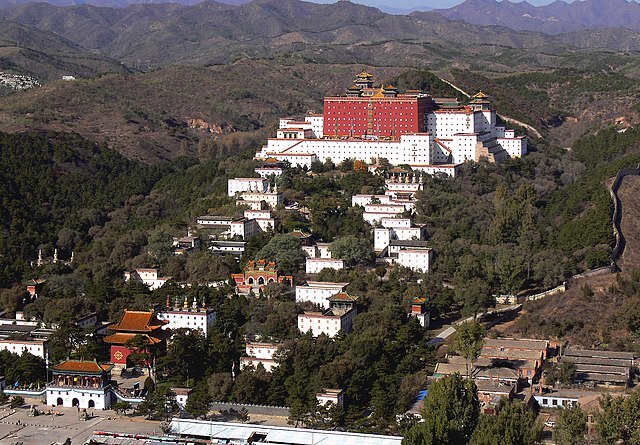
The Putuo Zongcheng Temple, a Buddhist temple in the Qing's Rehe Summer Resort (in today's Chengde, Hebei province). The temple was built between 1767 and 1771 by the Qianlong Emperor and was a replica of the Potala Palace in Lhasa. It is a fusion of Tibetan and Chinese architectural styles and is one of the most famous landmarks in the Chengde Summer Resort. (Image Source)
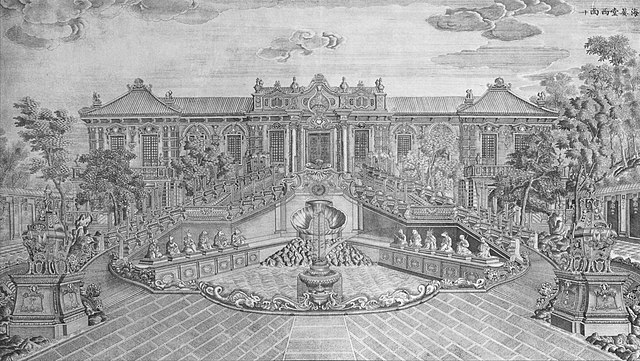
A painting of a European-style palace constructed by the Jesuits for the Qing emperors in the Old Summer Palace (Yuanmingyuan). Note the fusion of Chinese and European styles. The Old Summer Palace was looted and burned by Anglo-French forces in 1860. The twelve bronze head statutes in front of the building have mostly been repatriated back to China, although some are in the hands of private collectors. (Image Source)
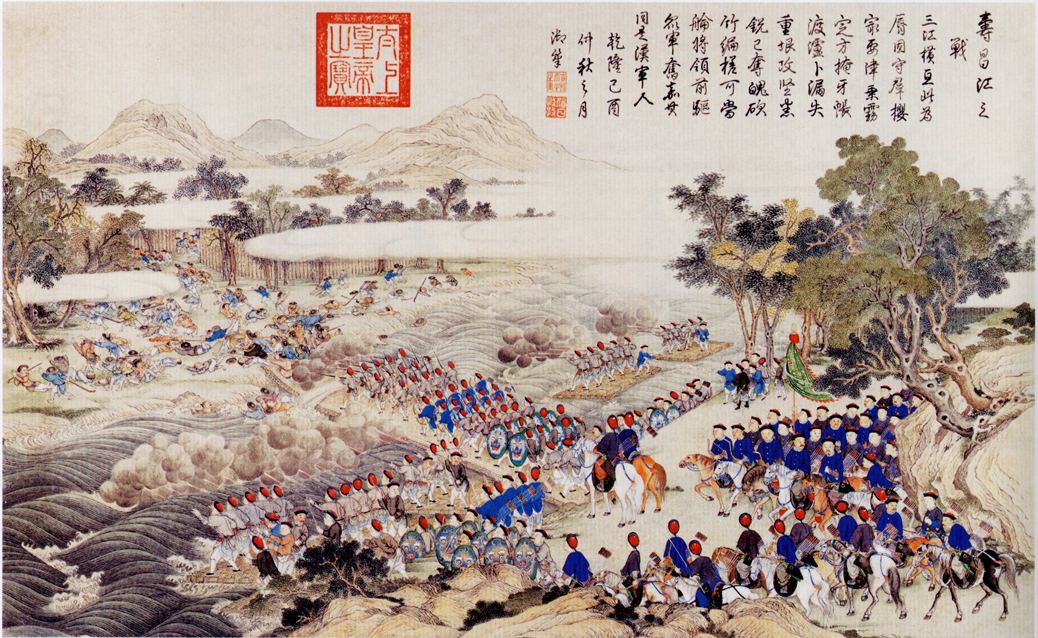
The Qianlong Emperor commissioned a series of artwork commemorating the "Ten Great Campaigns" of his reign. This particular piece of artwork depicts the Battle of Thọ Xương River in 1788, when the Qing invaded Vietnam. These artworks were collaborative pieces between Chinese and Jesuit painters. (Image Source)
References
Patricia Berger, Empire of Emptiness: Buddhist Art and Political Authority in Qing China. Honolulu: University of Hawaii Press, 2003.
Pamela K. Crossley, A Translucent Mirror: History and Identity in Qing Imperial Ideology. Berkeley: University of California Press, 1999.
Mark C. Elliott, The Manchu Way: The Eight Banners and Ethnic Identity in Late Imperial China. Stanford, CA: Stanford University Press, 2001.
Johan Elverskog, Our Great Qing: The Mongols, Buddhists, and the State in Late Imperial China. Honolulu: University of Hawaii Press, 2006.
Philippe Foret, Mapping Chengde: The Qing Landscape Enterprise. Honolulu: University of Hawaii Press, 2000.
Jonathan S. Hay, Shitao: Painting and Modernity in Early Qing China. Cambridge: Cambridge University Press, 2001.
Ho Ping-ti, “The Significance of the Ch’ing Period in Chinese History,” Journal of Asian Studies 26.2 (1967): 189-95
Ho Ping-ti, “In Defense of Sinicization: A Rebuttal of Evelyn Rawski’s `Reenvisioning the Qing,’” Journal of Asian Studies 57.1 (1998): 123-55.
Laura Hostetler, Qing Colonial Enterprise: Ethnography and Cartography in Early Modern China. Chicago: University of Chicago Press, 2001.
Susan Mann, Precious Records: Women in China’s Long Eighteenth Century. Stanford, CA: Stanford University Press, 1997.
James P. Millward, Beyond the Pass: Economy, Ethnicity, and Empire in Qing Central Asia, 1759-1864. Stanford, CA: Stanford University Press, 1998.
Ronald C. Po, The Blue Frontier: Maritime Vision and Power in the Qing Empire. Cambridge: Cambridge University Press, 2018.
Evelyn S. Rawski, The Last Emperors: A Social History of Qing Imperial Institutions. Berkeley: University of California Press, 1998.
Evelyn S. Rawski, “Presidential Address: Reenvisioning the Qing: The Significance of the Qing Period in Chinese History,” Journal of Asian Studies 55.4 (1996): 829-50.

